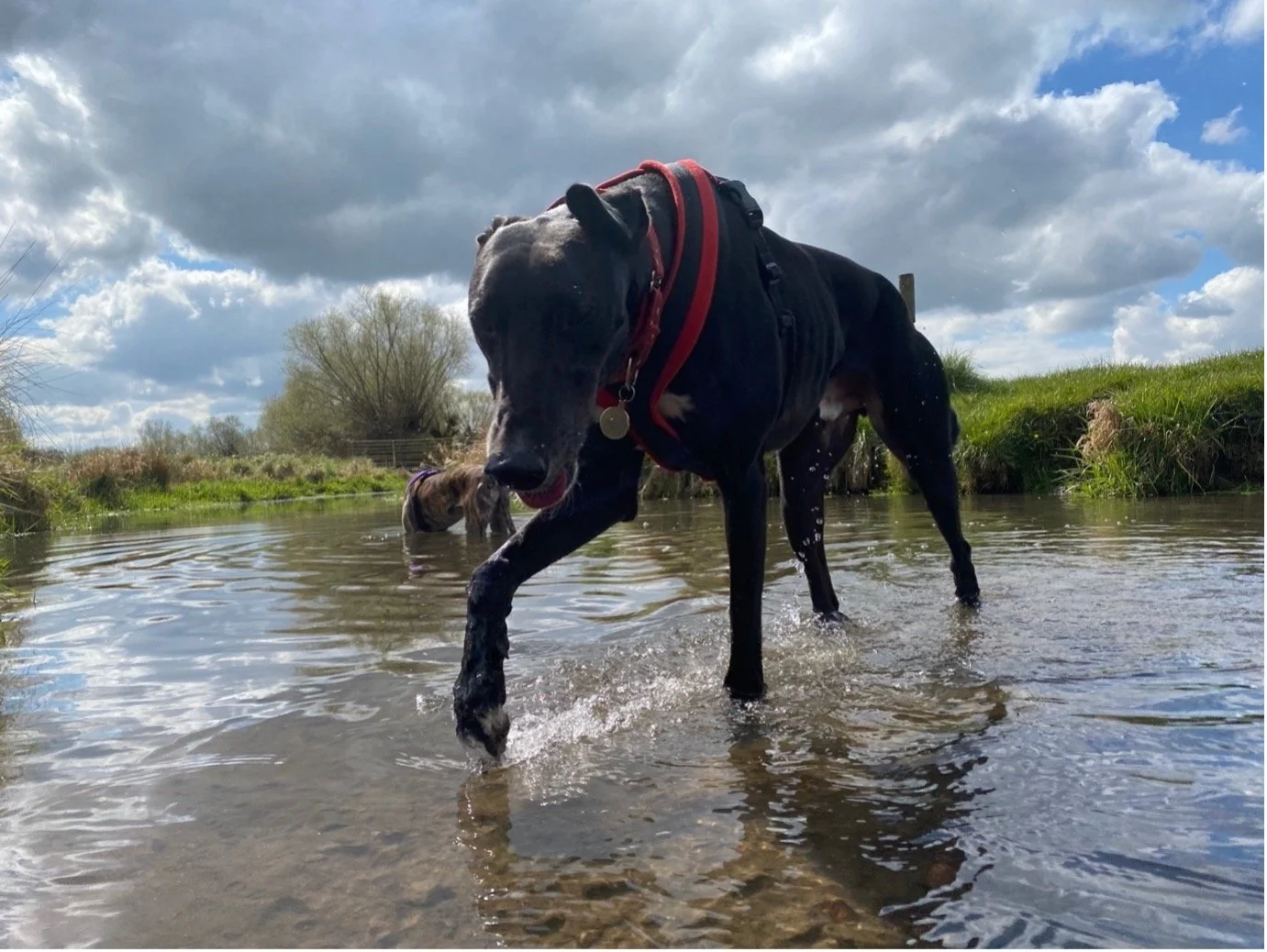The influence of pain on behaviour in dogs and cats
Pain is something that none of us usually want to encounter if we can at all avoid it. It can range from mildly unpleasant to all consuming agony. Pain may occur because of an acute injury, subsiding once tissue repair has occurred, or may manifest as chronic pain which continues well beyond a normal wound healing response [1].
The way in which sentient beings, including ourselves and our pets, experience pain very individual. This is the because the emotional experience of pain plays a significant role alongside the body’s physiological response to tissue damage. Once our emotions become involved then so do our behaviours!
Speaking from a personal perspective, I know that when I am experiencing pain my mood sinks like a stone in water. If I'm having a particularly painful flare up, I start to avoid doing things I would normally enjoy for fear of them hurting me. It really can become a vicious circle. The advantage I have is that I can explain where my pain is, what it feels like and therefore get help. When my pain is relieved, I go back to being in a good mood and behaving normally again.
But what if you are a non-human animal? All you can do to indicate that you are in pain is to change your behaviour. However, your behaviour could be misinterpreted as somehow being naughty, stubborn or even aggressive. This can lead to relationship breakdown between animals and their care givers. Alternatively, it might not be in your best interests to show that you are in pain if somehow that would appear to threaten your survival. Misinterpretation or non-recognition of pain indicators can have significant welfare implications for our animals.
So, what can we look out for?
If our pets are unfortunate enough to have an accident or suddenly become unwell it may be obvious that pain is involved.
Some years ago, one of my cats was climbing to the top of a cupboard. She somehow managed to then fall between two bookcases. Piecing together what happened afterwards it seems that she also managed to pull down a speaker which hit her foot, breaking four bones. Initially, she ran upstairs at speed and jumped on to the bed. On the face of it she had had a lucky escape.
However, we stayed with her and after a few minutes (presumably once her adrenalin started to subside) it became apparent that her normal lying down behaviour had changed. She was somehow flatter, and she did not make her normal chirping sound when we gently stroked her. In this case it was easy to spot that Pippin was in pain.
Fortunately, we realised quite quickly that she was going into shock. We rushed her to the vets (out of hours of course, it was New Year’s Eve!). They gave her very good care overnight. She subsequently had surgery that fixed all her broken bones and she seemed never to look back, not even a limp. She made a full recovery to the happy go lucky cat she had always been.
For another animal though, perhaps lacking Pippin’s coping skills that experience may have affected them differently from an emotional and learning perspective. In the future they may avoid weight bearing on the previously broken foot through fear of pain (which no longer exists, more on that later) or because chronic pain has genuinely set in.
Another much more subtle example of pain influencing behaviour is with our greyhound Riff Raff. He has several health issues including chronic pancreatitis with intermittent flare-ups. He is generally quite stoic (yes, he is definitely a greyhound!). It took us a little while to realise but we can now spot that when he becomes less tolerant of our young Labrador it usually correlates with him feeling uncomfortable. This has now become one of the first signs that we can recognise.
Carefully watching how our dogs and cats (and other species) behave in different circumstances on a normal day to day basis can really help us to spot more quickly when something might not be quite right. It could be as simple as refusing a meal on one occasion, avoiding going for a walk or hanging back to sniff more often. It could be that they take themselves off to a quiet area away from everyone else when perhaps they wouldn't normally do that. Or they may crave more attention than usual.
Sometimes it can be very hard to know if pain is involved in an animal’s new or ongoing ‘problem’ behaviour. The sign could be as subtle as a newly developed noise sensitivity [2]. If an experience is painful enough, just one occurrence can be sufficient for an animal to make an association between the pain and a coincidental person, dog, location, scent, time of day etc.
Therefore, when an animal has recovered from a painful experience, they could go on to fear re-occurrence of the pain in a similar or even a different situation. I know I do! This could appear to us that our dogs or cats are behaving inappropriately, perhaps showing aggressive behaviours where we don't think it is at all warranted.
There is also the issue of actual chronic pain. This could be the result of an ongoing health issue such as osteoarthritis. As I said earlier when I'm in pain my mood crashes. This makes it more difficult for me to cope with things that might not go quite as I would have liked them to. This could be similar for our pets especially now that it is commonly accepted that animals can experience a range of positive and negative emotions [3, 4].
Sometimes I'm asked by clients ‘Why do I have to take my dog or cat to the vet before I can start working with you to address their problem behaviour?’ It often surprises them to learn that up to 80% of dog and cat cases referred to behaviour clinics can involve an element of pain [5].
Without resolving underlying pain or health issues first no amount of behaviour modification work or training is going to fully resolve the problem behaviour. In fact, it could make things worse by if an animal is forced to participate in training they are not physically or emotionally capable of. This is why a bone fide animal behaviourist will only work on referral from a vet who in turn has satisfied themselves that the animal is fit and healthy prior to behaviour modification therapy. It is true that occasionally pain may not be observed during a check-up, some animals can be very good at hiding pain if they're feeling worried for example. This is not a reason to skip a vet referral though!
Quite the opposite in fact. Behaviourists can spend many hours observing an animal they are working with so have a huge advantage in terms of available time to really see how the animal behaves on a day-to-day basis. With the vet already on board and fully aware of the work the behaviourist will be doing with their mutual client’s animal, the door is immediately open to go back to request their input. Win-win!
The bottom line is: pain influences behaviour (and probably vice versa but that’s another story).
About the author
Julie Daniels is a certified companion animal behaviourist and professional dog trainer. Julie’s specialist interest is in working with animal emotions, the critical and often misunderstood key to preventing and resolving problematic animal behaviours. Her knowledge and practical experience come from her COAPE Diploma in the Principles and Practical Application of Companion Animal Behaviour and Training, a Master’s degree in Clinical Animal Behaviour and extensive CPD. Julie’s MSc research dissertation 'An evaluation of the behaviour consultation and factors influencing advice compliance from the perspective of pet dog owners' won the prize for best dissertation thesis (University of Edinburgh) and has been published in the Journal of Veterinary Behaviour (2 papers) .
Credentials
Certified Animal Behaviourist and Trainer: COAPE Association of Applied Pet Behaviourists and Trainers
Pre-Certification (Certificated Clinical Animal Behaviourist): Association for the Study of Animal Behaviour
Candidate Member: Fellowship of Animal Behaviour Clinicians
Certified Animal Behaviourist and Trainer: International Companion Animal Network
Full Member: Association of Pet Dog Trainers
Registered Animal Training Instructor: Animal Behaviour and Training Council
Julie offers training and behaviour modification for dogs and cats in Bedfordshire, UK.
If you would like to learn more about how Julie could help you and your pet, click on the button below or please feel free to contact her on juliedaniels@thinkingpaws.co.uk.
References
Colvin, L.A. and M. Fallon, ABC of Pain. 2012, UK: Blackwell Publishing Ltd.
Fagundes, A.L.L., et al., Noise sensititvities in dogs: An exploration of signs in dogs with and without musculoskeletal pain using qualitative content analysis. Front. Vet. Sci., 2018. 5(17): p. 1-5.
Panksepp, J., Affective neuroscience: The foundations of human and animal emotions. 1998, New York, USA: Oxford University Press, Inc. 466.
Panksepp, J., The basic emotional circuits of mammalian brains: Do animals have affective lives? Neuro. Bio. Rev., 2011. 35: p. 1791-1804.
Mills, D.S., et al., Pain and problem behavior in dogs and cats. Animals, 2020. 10(2): p. 318-338.




